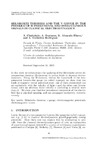
Please use this identifier to cite or link to this item:
http://ricaxcan.uaz.edu.mx/jspui/handle/20.500.11845/516Full metadata record
| DC Field | Value | Language |
|---|---|---|
| dc.contributor.other | https://orcid.org/0000-0001-5324-1834 | es_ES |
| dc.contributor.other | https://orcid.org/0000-0002-1478-7946 | es_ES |
| dc.coverage.spatial | Global | es_ES |
| dc.creator | Chubykalo, Andrew | - |
| dc.creator | Espinoza, Augusto | - |
| dc.creator | Alvarado Flores, Rolando | - |
| dc.creator | Gutiérrez Rodríguez, Alejandro | - |
| dc.date.accessioned | 2018-06-08T19:31:15Z | - |
| dc.date.available | 2018-06-08T19:31:15Z | - |
| dc.date.issued | 2006-02 | - |
| dc.identifier | info:eu-repo/semantics/publishedVersion | es_ES |
| dc.identifier.issn | 1572-9524 | es_ES |
| dc.identifier.issn | 0894-9875 | es_ES |
| dc.identifier.uri | http://hdl.handle.net/20.500.11845/516 | - |
| dc.identifier.uri | https://doi.org/10.48779/88r6-ww76 | - |
| dc.description.abstract | In this work we substantiate the applying of the Helmholtz vector decomposition theorem (H-theorem) to vector fields in classical electrodynamics. Using the H-theorem, within the framework of the twoparameter Lorentz-like gauge (so called v-gauge), we show that two kinds of magnetic vector potentials exist: one of them (solenoidal) can act exclusively with the velocity of light c and the other one (irrotational) with an arbitrary finite velocity v (including a velocity more than c) . We show also that the irrotational component of the electric field has a physical meaning and can propagate exclusively instantaneously. | es_ES |
| dc.language.iso | eng | es_ES |
| dc.publisher | Foundations of Physics Letters | es_ES |
| dc.relation | https://link.springer.com/article/10.1007/s10702-006-1847-y | es_ES |
| dc.relation.uri | generalPublic | es_ES |
| dc.rights | Atribución-NoComercial-CompartirIgual 3.0 Estados Unidos de América | * |
| dc.rights.uri | http://creativecommons.org/licenses/by-nc-sa/3.0/us/ | * |
| dc.source | Foundations of Physics Letters, Vol. 19, Núm. 1, Febrero 2006 | es_ES |
| dc.subject.classification | CIENCIAS FISICO MATEMATICAS Y CIENCIAS DE LA TIERRA [1] | es_ES |
| dc.subject.other | Helmholtz theorem | es_ES |
| dc.subject.other | v-gauge | es_ES |
| dc.subject.other | electromagnetic potentials | es_ES |
| dc.subject.other | electromagnetic waves | es_ES |
| dc.title | Helmholtz theorem and the V-Gauge in the problem of superluminal and instantaneous signals in classical electrodynamics | es_ES |
| dc.type | info:eu-repo/semantics/article | es_ES |
| Appears in Collections: | *Documentos Académicos*-- UA Física | |
Files in This Item:
| File | Description | Size | Format | |
|---|---|---|---|---|
| 2006 Found. Phys. Let..pdf | 322,66 kB | Adobe PDF |  View/Open |
This item is licensed under a Creative Commons License
